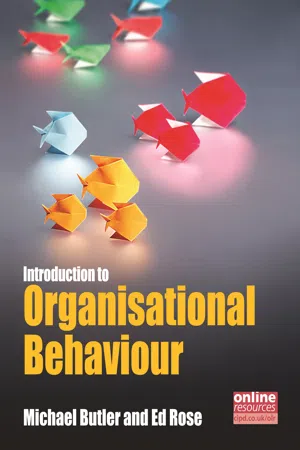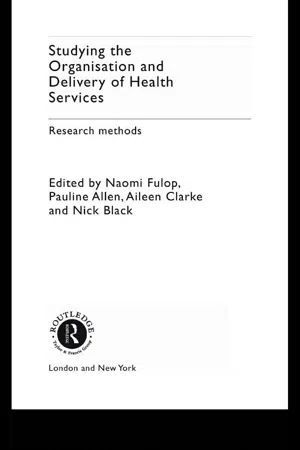Business
The Study of Organizational Behavior
The study of organizational behavior focuses on understanding how individuals, groups, and structures within an organization interact and influence one another. It explores topics such as leadership, communication, motivation, and decision-making to improve organizational effectiveness and employee well-being. By examining these dynamics, organizations can enhance their performance and create a more positive work environment.
Written by Perlego with AI-assistance
Related key terms
9 Key excerpts on "The Study of Organizational Behavior"
- eBook - ePub
Organizational Behavior 3
Historical Origins, Theoretical Foundations, and the Future
- John B. Miner(Author)
- 2006(Publication Date)
- Routledge(Publisher)
Although the exact boundaries of the discipline are somewhat fuzzy (see Blood 1994), organizational behavior’s focus is clearly on the world of organizations. The concern is first with the behavior and nature of people within organizations, and second with the behavior and nature of organizations within their environments. The term organizational behavior initially referred only to the behavior and nature of people in organizations. Given the fuzziness of its boundaries, the discipline always had a tendency to stretch beyond that domain, however. By the time it approached twenty-five years of age it clearly had staked a claim to incorporating the behavior and nature of organizations as well (see Miles 1980). This is historically consistent in that both the study of the behavior and nature of people and the study of the behavior and nature of organizations emerged in the business schools in the same places at the same times.In line with its professional school origins, organizational behavior is an applied discipline, concerned with matters of practice and application. Despite this orientation, it currently has relatively few members who actually devote their primary professional efforts to the practice of organizational behavior in business and other organizational settings; rather, most are concentrated in academia—teaching, writing, and conducting research. In my opinion this is unfortunate; the field would be better off not by reducing its academic efforts, but by expanding its practitioner efforts. We will return to this theme in various ways throughout this book.Several other terms have become intertwined with organizational behavior over the years, although none has achieved quite the same level of acceptance. One is organization theory, which has come to refer almost exclusively to the study of the behavior and nature of organizations in their environments. A second is organization(al) science, which appears to cover essentially the same ground as organizational behavior, and which in many respects I prefer as a designation for our field (see Miner 1984). However, right now organizational behavior has won the day. Finally, there is the term organization studies, which also has a broad connotation extending, at least in the recent period, beyond the science of organizations to incorporate several different philosophic positions (see Clegg, Hardy, and Nord 1996).Having explained what organizational behavior is, I need to say something about what it is not. It is not strategic management, a field that has emerged and achieved stature more recently than organizational behavior (see Schendel and Hofer 1979) and has differentiated itself at the border that previously existed between organizational behavior and economics, borrowing from and overlapping with each. Furthermore, organizational behavior is not economics - eBook - ePub
Organizational Behaviour
Performance Management in Practice
- Richard Pettinger(Author)
- 2013(Publication Date)
- Routledge(Publisher)
Moreover, each discipline and perspective is incomplete and imperfect. Each is in itself an ever-developing and enlarging field. However, this at least indicates why a full understanding of organizational behaviour is not yet achieved and the context in which studies in the field are to be seen.The disciplines of organizational behaviour
The main disciplines that contribute to the study of organizational behaviour are as follows. In summary, they are concerned with the capabilities and potential of people; influences on capabilities; the attitudes and behaviour of people; influences on behaviour; the organizational context; organizational processes and the execution of work; and interaction with the environment.- Psychology: the study and understanding of human personality and behaviour, the traits and characteristics of individuals; their perceptions, attitudes, values, beliefs and motives; their goals and priorities; their capabilities and potential.
- Sociology: the study of behaviour in groups; influences on this behaviour; interactions between groups; the extent to which people organize themselves and the ways in which they do this; processes of socialization (the ordering and limiting of individual behaviour by groups and the environment); the creation of norms, rules and regulations.
- Anthropology: the study of large groups, nations and cultures; global beliefs, customs, ideas and values; the wider processes of socialization (for example, through religious activities, caste systems, aristocracies, technocracies).
- Economics: the study of the ordering, use and distribution of the world’s resources; of gathering and using these to best effect in particular situations and in the pursuit of stated aims and objectives.
- Ethics: the establishment of absolute standards which relate, above all, to the nature of interpersonal relationships and interactions, including standards of honesty, integrity, probity, value, esteem and respect.
- Mathematics and statistics
- eBook - ePub
- Paul Smith, Marilyn Farmer, Wendy Yellowley(Authors)
- 2013(Publication Date)
- Routledge(Publisher)
Exploring the organizational part of the term a bit further, OB is also concerned with how organizations are designed and structured, and how they function. Organizations will also be influenced by the external environment or context in which they operate. So here, some understanding of sociology will undoubtedly be important, and of organizational studies, politics and economics.Combining the elements, however, reminds us that each will have an influence on the other: thus, how organizations are designed and run will affect individuals and groups within them, while, of course, ‘organizations’ themselves and how they are run are an outcome of individuals and groups of individuals.ACTIVITYDefinitions and meanings Here are a number of, and views about, OB:that aspect of theory and practice concerned with the behaviour of individuals and groups in organizational contexts(MARTIN AND FELLENZ 2010: 14)the study of the structure, functioning and performance of organizations, and the behaviour of groups and individuals within them(PUGH 1971: 9)the study and understanding of individual and group behaviour and patterns of structure in order to help improve organizational performance and effectiveness(MULLINS 2010: 3)a field of study that investigates the impact that individuals, groups, and structure have on behaviour within organizations for the purpose of applying such knowledge toward improving an organization's effectiveness(ROBBINS et al. 2010: 7)a multidisciplinary field of enquiry, concerned with the systematic study of formal organizations, the behaviour of people within organizations, and important features of the social context, that structures all the activities that occur inside the organization(BRATTON et al. 2010: 9)in leading textbooks, OB tends to be presented as largely cut-and-dried and settled, thus lacking any controversy, conflict or contest, yet such appearances are deceptive. There are fundamental differences of view – cultural, political and ethical – about how organizations are organized, how they should be organized and how they can be studied. To some extent, these mirror and amplify differences of opinion and preference among people working in organizations (between factions of senior managers for example) about how to organize and manage their operation. - eBook - ePub
Rethinking Leadership
A Critique of Contemporary Theories
- Annabel Beerel(Author)
- 2021(Publication Date)
- Routledge(Publisher)
3 Organizational behavior influences and studies- Introduction
- Evolution of leadership theories
- Psychology and leadership
- Psyche lost
- All things are possible
- Psyche regained
- Scientific management
- Mary Parker Follett
- The human relations movement
- Elton Mayo (1880–1949)
- Peter Drucker (1909–2005)
- Douglas McGregor (1906–1964)
- Abraham Maslow (1908–1970)
- Organizational development
- Definition of OD
- OD as a process
- Roots of OD: Kurt Lewin (1898–1947)
- Rensis Likert (1903–1981)
- Chester Barnard (1886–1961)
- Elliott Jacques (1917–2003)
- David McClelland (1917–1998)
- Learning organizations
- Decline of organizational development
- Herzberg, motivation, and hygiene factors
- Organizational behavior
- Summary of early theories
- Executive summary
- Questions
- References
Introduction
Since the late 19th century, researchers have engaged in the study of organizations, their processes, how they are led, and the factors that influence human behavior. Psychologists have been at the forefront of this research, and their ideas have influenced managerial styles and techniques over the decades. These research studies were known as studies into organizational behavior, and the study of leadership was initially carried out under this rubric.Since the late 1960s, however, due to recognition of the significant influence of leadership on the success and failure of organizations, leadership studies blossomed into a separate discipline with their own theories and research investigations. This divorce of leadership from the wider context of organizational behavior has had several negative consequences. For one, many leadership theories exclude the context of the organization as a social system and the implications for leading. Another consequence of the isolation of leadership theories is that they often ignore or seem oblivious to the grounding research studies originally carried out by thoughtful psychologists into how humans behave at work. - eBook - ePub
- Michael Butler, Ed Rose(Authors)
- 2011(Publication Date)
- CIPD - Kogan Page(Publisher)
Despite this being the case, organisational behaviour is usually studied in the context of organisations (as entities) and is focused on the formal rather than informal dynamics within organisations. This means that our understanding of organisational behaviour is often limited in its scope. This partial account is at the same time partisan – focusing on the view of behaviour from the perspective of management and how other employees can be managed more effectively to achieve goals such as profitability. Even though, as has been the case in more recent years, the informal aspect of organising has received more attention, many texts on organisational behaviour still give more attention to managing and achieving ‘good behaviour’ while neglecting the everyday lived experience of organisation and the nature and reasons behind so-called ‘misbehaviour’ (Ackroyd and Thompson, 1999). Furthermore the context of organisation is usually limited to that of legitimised paid employment (Wilson, 2010). Thinking about organisational behaviour in relation to processes of organis ing opens us to think about organisational behaviour in broader terms – and will also enable those with little or no work experience to draw on knowledge and life experience to understand these concepts. It is common to differentiate between ‘levels’ of interaction in organisational behaviour. Usually this is divided into the behaviours of ‘individuals’, ‘groups’, and the effects of ‘structure and processes’. But of course these are inherently intertwined and need to be understood as mutually constituting. Divisions between levels or topics (culture, group, personality, and so on) are artificial divisions. They allow us to break down and make sense of work, organisation, and management. Trying to say everything about all things at all times becomes an impossible exercise. However, we do need to keep in mind that the divisions we make are just devices for organising our knowledge into manageable proportions - eBook - ePub
- Ivan P. Pavlov(Author)
- 2017(Publication Date)
- Routledge(Publisher)
Chapter Three Human Behavior and OrganizationTHE present chapter will focus attention upon the individual employee of governmental organizations, upon the forces that account for his behavior, and upon the influences that the organization brings to bear on him in order to secure his contribution to the organization's tasks. At first sight there hardly seems to be a problem here. If we employ a man to direct activities at a playground, of course he will spend his time each day from nine to five at the playground; of course he will organize and direct play activities there; of course he will carry out the policies formulated by the directors of the organization who are responsible for planning its program. Only the many instances of organization failure—instances where an organization does not carry out its task or where it succeeds at an excessive economic and human cost—warn us that there is really nothing automatic about the process.Organizational behavior is such an obvious part of everyday experience that we are seldom conscious of the psychological reasons for its successes and failures. We sometimes forget that an organization is a group of people behaving. These people are not tools or machines. They have feelings, hopes, and fears. They get sick, hungry, angry, frustrated, happy, sad. Their behavior is subject to a whole range of influences extending back to their births (and before, many psychologists believe) and impinging upon them from all directions at every moment. Their behavior in organizations is a resultant of all these influences. Some of the more important of the influences will be described in this chapter.Characteristics of Behavior in Organizations
A person can do but a limited number of things at any particular time. However, there are a nearly unlimited number of things he might be doing at that time. To explain a person's behavior, we must understand why he is doing what he is doing in a particular way rather than something else or in another way. - eBook - ePub
- Brian Lehaney, Phil Lovett, Mahmood Shah(Authors)
- 2011(Publication Date)
- Routledge(Publisher)
Factors in the internal and external environments can affect organizational behaviour and change management. Ineffective change can result in loss of time, resources, money and trust, and these can be disastrous for an organization. Organizational structures have changed radically in the last quarter of the twentieth century. During industrialization, structures tended to be bureaucratic, power came from the top, tasks were of a routine level and most employees were not supposed to take part in decision-making processes. This trend continued directly after the Second World War, when it was initially thought that methods of managing military operations could be used in civilian organizations. It soon became apparent that this was not the case. As Western economies shifted from industry to services, and knowledge workers became more common, different approaches to management had to be developed. Today, employees are not simply practitioners, they now have closer social relations with the external environment, and organizations need to consider employee satisfaction and commitment as a strategic element to increase participation, increase productivity and decrease employee turnover.This chapter discusses concepts of organization structure and behaviour, the practice of organizing within the workplace and some of the human resource functions that relate to OB. Areas of interest include theories of organizations, approaches to management – including classical, scientific and human relations – and contingency theory. The nature of organizations, organizational goals, strategies and responsibilities, managerial behaviour and leadership are covered. Topics include design of structure, objectives, functions, span of control, chain of command, patterns of work, organization structure and change management. The chapter concludes with human resource aspects, such as the individual in the organization, work motivation and rewards.10.3 Organizational culture
Organizational culture may be considered as a set of values, beliefs, understandings and ways of thinking that are shared by members of an organization. Such culture will be taught to new members of the group, and used to help face external problems together and to protect the group from outsiders – for example, to protect resources. Culture is also used to present a common image to those outside the group, to deter people the group may consider undesirable and to attract those the group considers desirable. - eBook - ePub
Studying the Organisation and Delivery of Health Services
Research Methods
- Pauline Allen, Pauline Allen, Nick Black, Aileen Clarke, Naomi Fulop, Stuart Anderson(Authors)
- 2004(Publication Date)
- Routledge(Publisher)
Chapter 5 Organisational psychologyJohn Arnold
Introduction
Psychology as a discipline concerns the description, explanation and prediction of behaviour, thoughts and emotions. Organisational psychologists draw upon a range of theoretical and methodological traditions in seeking to address issues to do with human behaviour, thoughts and emotions at work. Most of this work is not specific to health care settings, but is designed to be generalisable to many contexts. Existing research and theory have something to say of practical importance in health service delivery and organisation, even though it is rarely framed in ways that exactly match health service managers’ day-to-day concerns or vocabulary. The methods used by organisational psychologists permit the investigation of a wide range of topics and a choice of underlying research philosophy. There are many published examples of organisational psychology making significant potential and actual contributions to health service delivery and organisation, particularly concerning aspects of human resource management.Definition and theoretical basis
There are a number of sub-disciplines within psychology, including elements drawn from the arts, humanities, and the biological and physical sciences as well as social science. One way of viewing the sub-disciplines is as follows. - eBook - ePub
- David Langford, R.F. Fellows, M. R. Hancock, A.W. Gale(Authors)
- 2014(Publication Date)
- Routledge(Publisher)
Chapter 4Organizational behaviour
Modern society abounds with organizations. Whether it is as the most junior member of a youth club or the chairman of a multinational corporation we all belong to an organization of some kind during our lives. It might seem easy in that case to define what we mean by the word, but this does not appear to be the case. Wherever we look in the management literature we find differing definitions of the organization.The organization
Consider the following few examples:• Organizations are grand strategies individuals create to achieve objectives that require the effort of many (Argyris, 1965).• By organization, we mean social units devoted to the attainment of specific goals. In this sense, organization stands for ‘complex bureaucratic organization’ (Etzioni, 1964).• An organization is a social device for efficiently accomplishing through group means some stated purposes; it is the equivalent of the blueprint for the design of the machine which is to be created for some practical objective (Katz and Kahn, 1966).• The process of co-ordinating different activities to carry out planned transactions with the environment (Lawrence and Lorsch, 1967).The distinguishing features between organizations like the youth club and a major corporation are the purpose of the organization and the need to be formally structured and organized. This need is likely to arise from the complexity of task and size of organization. We might, then, usefully separate business or formal organizations from social or (relatively) informal organizations.Organizational planning
For an organization to be efficient, effective and robust, it must be able to cope with risk and uncertainty. Rarely can this state of health be achieved by chance so plans must be made. Aims and objectives must be agreed upon and goals and targets established.
Learn about this page
Index pages curate the most relevant extracts from our library of academic textbooks. They’ve been created using an in-house natural language model (NLM), each adding context and meaning to key research topics.








